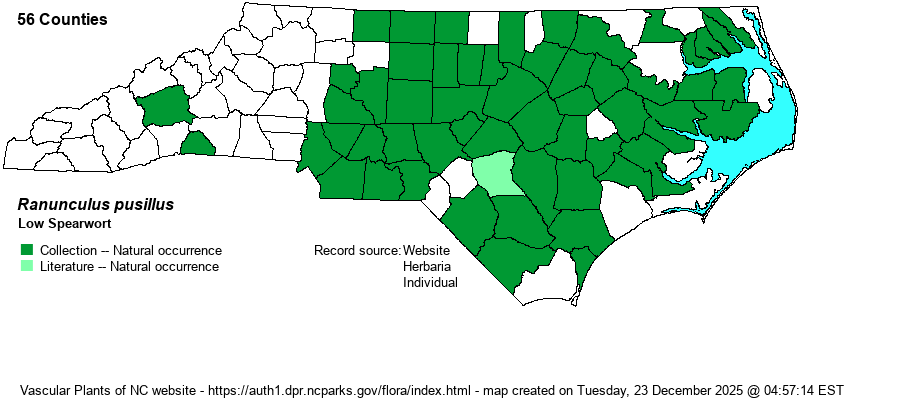| Author | Poiret | |
| Distribution | Present over nearly all of the Coastal Plain and the eastern and central Piedmont; only a few records for the western third of the state, with just one Mountain county (Buncombe) represented by a specimen.
This is a Southeastern species, ranging from southeastern NY and MO south to central FL and central TX.
| |
| Abundance | Fairly common to frequent in the Coastal Plain and eastern and central Piedmont; easily overlooked and may well occur in nearly all Coastal Plain counties, and in Piedmont counties west to Stokes, Rowan, and Union. Very rare farther west, and seemingly absent over most of the Mountains. | |
| Habitat | This is a somewhat weedy buttercup, and though native, it grows in often disturbed, damp to wet sites, mostly in full sun. It occurs in ditches, margins of marshes and wet thickets, openings in swamps or bottomlands, wet slight depressions in forests, and in damp or wet scrapes. | |
| Phenology | Blooms from April to June, and fruits shortly after flowering. | |
| Identification | This is a rather small species, easily passed over by biologists owing to very small flowers. It has small basal leaves, each on long petioles about 2 inches long, but with a small blade only about 1 inch long or less, mainly elliptical and entire. The several flowering stalks can reach about 1-1.5 foot tall, at times leaning. A few quite narrow leaves grow along the stalks. At the ends of these stalks are the tiny flowers, with 5 short sepals that are pale to medium yellow but only about 1/8-inch long, and the 1-3 petals are even smaller. Thus, a flower consists mainly of the sepals and spreading barely 1/4-inch across in full bloom. The entire plant is essentially glabrous, and often looks a bit fleshy and waxy. Though each plant is easily overlooked, the species can often grow in sizable colonies on exposed mud or shorelines or marsh edges. | |
| Taxonomic Comments | None
| |
| Other Common Name(s) | Small Spearwort | |
| State Rank | S5 | |
| Global Rank | G5 | |
| State Status | | |
| US Status | | |
| USACE-agcp | FACW link |
| USACE-emp | OBL link |

